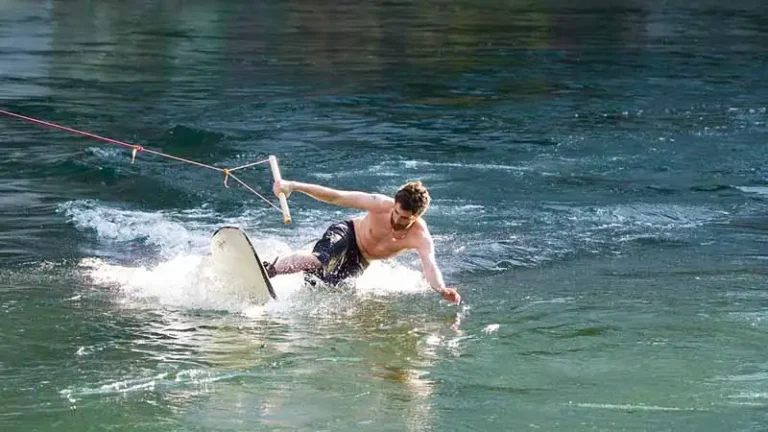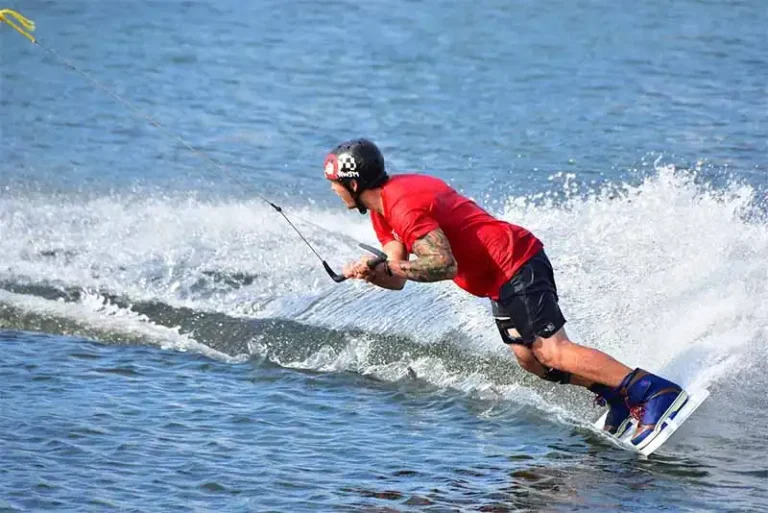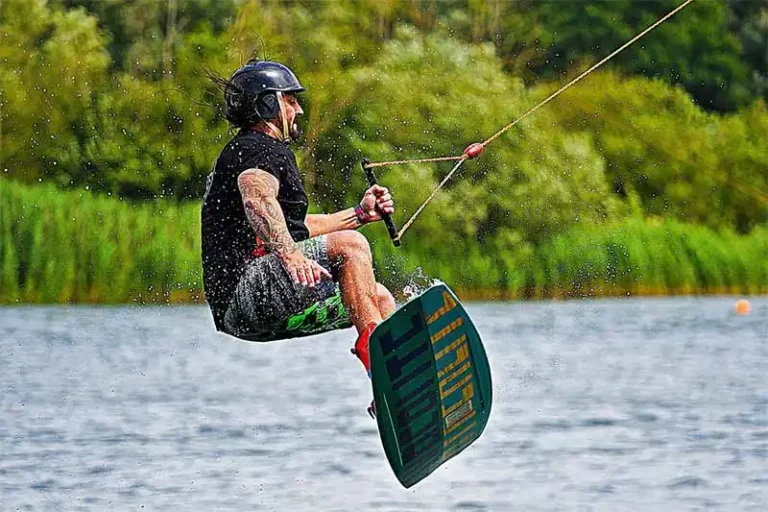Best Wakeboard Helmets with Ear Protection for Safe Riding
Wakeboarding is an exhilarating water sport that combines speed, skill, and a lot of adrenaline.
However, like any extreme sport, it comes with its share of risks. Wearing a helmet designed specifically for wakeboarding is not just a recommendation—it’s a necessity.
A high-quality wakeboard helmet helps protect your head from impacts, whether from unexpected falls, collisions with obstacles, or the board itself.
But there’s more to safety than just shielding your head. Helmets with built-in ear protection add an extra layer of defense, safeguarding your ears from powerful water pressure and potential injuries like ruptured eardrums.
This feature is particularly important for riders who spend a lot of time attempting tricks or riding in rough waters.
The ear protection also improves overall comfort by preventing water from rushing into your ears, allowing you to stay focused and enjoy your ride.
In this guide, we’ve done the research for you, curating a list of the best wakeboard helmets with ear protection to make your water adventures safer and more enjoyable.
Whether you’re a seasoned wakeboarder or just starting out, this article will help you find the perfect helmet to suit your needs.
Why Choose Wakeboard Helmets with Ear Protection?
Wakeboarding is a thrilling sport, but it’s also one where safety should never be overlooked.
While helmets are essential for protecting your head, wakeboard helmets with ear protection offer even more advantages, making them a smart investment for any rider.
Protecting Your Head and Ears from Impacts and Water Pressure
Wakeboarding involves high speeds and occasional hard falls. A helmet with ear protection shields your head from impacts while also protecting your ears from direct blows or high-pressure water that can cause discomfort or injuries.
This dual protection is especially valuable in rough waters or when attempting advanced tricks.
Enhanced Comfort During High-Speed Rides and Tricks
Wakeboard helmets with ear protection are designed to enhance comfort as well as safety. The ear pads help block water from rushing into your ears, which can be distracting and uncomfortable during a ride.
With this added comfort, you can focus fully on your performance without being bothered by the elements.
Preventing Serious Ear Injuries
One of the biggest risks during wakeboarding is ear injuries, such as ruptured eardrums, caused by the force of water entering the ear canal at high speeds.
Helmets with ear protection significantly reduce this risk by providing a barrier that minimizes water impact.
For frequent riders or those practicing high jumps and flips, this added layer of safety is crucial.
Additional Features for Improved Performance
Many wakeboard helmets with ear protection come with water-resistant materials, ensuring durability even after prolonged exposure to moisture.
They also have drainage systems to keep water from pooling inside, maintaining a lightweight and comfortable fit throughout your session.
By choosing a wakeboard helmet with ear protection, you’re prioritizing both your safety and enjoyment on the water.
Whether you’re a beginner or an experienced wakeboarder, this type of helmet can make a significant difference in your overall experience.
Key Features to Look for in Wakeboard Helmets with Ear Protection
When choosing the best wakeboard helmet with ear protection, it’s essential to focus on features that ensure both safety and comfort.
A well-designed helmet not only protects you but also enhances your overall experience on the water. Here are the key features to keep in mind:
Durable Materials for Maximum Protection
The material of the helmet plays a significant role in its durability and effectiveness. Look for helmets made with tough ABS (Acrylonitrile Butadiene Styrene) shells, known for their ability to withstand impacts.
Additionally, inner linings made from EVA (Ethylene Vinyl Acetate) foam provide excellent shock absorption, ensuring your head is well-protected even during hard falls.
Built-In Ear Protection
Helmets with ear protection come in two main types: removable and fixed ear pads. Removable ear pads are versatile, allowing you to customize the helmet based on your preferences or weather conditions.
Fixed ear pads, on the other hand, offer consistent protection and are ideal for riders who prioritize safety in all conditions.
Ventilation and Drainage Systems
Wakeboarding involves constant exposure to water, so a good helmet should have built-in drainage holes to quickly release any water that enters.
Proper ventilation systems are also critical to prevent the helmet from feeling too hot or heavy during extended sessions.
These features ensure you stay comfortable and focused on your ride.
Fit and Sizing Options for Secure Wear
A helmet that fits correctly is crucial for both safety and comfort. Most wakeboard helmets come in various sizes with adjustable straps or padding to provide a snug fit.
Be sure to measure your head circumference and consult the sizing guide provided by the manufacturer.
A secure helmet minimizes movement during impacts and ensures reliable protection.
Certification Standards for Safety Assurance
Always look for helmets that meet recognized safety standards, such as CE EN 1385 certification, which is specifically for water sports helmets.
Certified helmets have been rigorously tested to ensure they offer adequate protection for activities like wakeboarding.
This certification gives you peace of mind knowing your helmet meets safety requirements.
By focusing on these features, you can confidently select a helmet that prioritizes safety, comfort, and durability.
A well-chosen helmet will not only keep you protected but also enhance your performance and enjoyment on the water.
How to Choose the Right Wakeboard Helmet for Your Needs
Selecting the right wakeboard helmet is crucial to ensuring your safety, comfort, and enjoyment on the water.
With so many options available, it’s important to consider factors that align with your wakeboarding style and personal preferences.
Here’s how to find the perfect helmet for your needs:
Determine Your Wakeboarding Style and Frequency
Start by assessing how often you wakeboard and the type of riding you do. If you’re an occasional rider or stick to basic maneuvers, a standard helmet with ear protection will suffice.
However, if you regularly perform tricks, ride in rough waters, or compete, you’ll need a helmet with advanced features like reinforced ear pads and premium impact resistance. Frequent riders should prioritize durability and long-lasting materials.
Measure for the Correct Helmet Size
A proper fit is essential for a wakeboard helmet to offer optimal protection. To determine your size, measure the circumference of your head just above your eyebrows and ears.
Compare your measurements with the manufacturer’s size chart to ensure a snug yet comfortable fit.
Many helmets also come with adjustable straps and padding, allowing you to fine-tune the fit for added security.
Balance Cost vs. Safety Features
While it may be tempting to choose an affordable wakeboard helmet, safety should always come first.
Look for helmets that meet recognized safety standards, like CE EN 1385 certification, even if they cost a bit more.
These helmets are designed to handle high-impact falls and provide reliable ear protection. If budget isn’t a concern, consider premium helmets that offer advanced materials, better ventilation, and customizable features for enhanced comfort.
Consider Personal Preferences
Your wakeboard helmet should reflect your personal style and preferences. From sleek designs and vibrant colors to trusted brands, there’s something for everyone.
While aesthetics shouldn’t outweigh safety, choosing a helmet you love can make you more likely to wear it consistently.
Additionally, consider added features like removable ear pads, quick-dry linings, or lightweight construction for extra convenience.
By taking the time to evaluate these factors, you can find a wakeboard helmet that meets your safety needs while complementing your style.
Whether you’re a casual rider or an avid wakeboarder, investing in the right helmet will make your time on the water safer and more enjoyable.
Maintenance Tips for Wakeboard Helmets
Taking good care of your wakeboard helmet is essential for maintaining its performance, durability, and safety.
A well-maintained helmet not only lasts longer but also provides reliable protection every time you hit the water.
Here are some practical tips to keep your wakeboard helmet in top shape:
Clean and Dry Your Helmet Properly After Use
After every wakeboarding session, rinse your helmet with clean, freshwater to remove salt, dirt, or chlorine that can degrade its materials over time.
Avoid using harsh chemicals or abrasive cleaners, as they can damage the shell and padding.
Once cleaned, let the helmet air dry completely in a well-ventilated area, away from direct sunlight, which can weaken the materials.
Check for Wear and Tear
Regularly inspect your helmet for signs of damage, such as cracks in the shell, frayed straps, or worn-out ear pads.
Even minor damage can compromise the helmet’s protective capabilities, so address any issues immediately.
If your helmet has sustained a significant impact, it’s a good idea to replace it, as the internal structure may no longer provide adequate protection.
Store Your Helmet to Maintain Its Shape and Durability
Proper storage is key to extending your helmet’s lifespan. Store your helmet in a cool, dry place where it won’t be exposed to extreme temperatures or heavy objects that could deform its shape.
Using a protective helmet bag can add an extra layer of care, shielding it from dust and scratches when not in use.
Replace Worn Parts When Necessary
Many wakeboard helmets come with replaceable ear pads and liners. If these components become worn or lose their fit over time, consider replacing them to maintain the helmet’s comfort and effectiveness.
Always use manufacturer-approved parts to ensure compatibility.
Follow Manufacturer Guidelines
Every helmet is different, so be sure to read and follow the care instructions provided by the manufacturer.
These guidelines are tailored to your specific helmet model and can help you avoid mistakes that might shorten its lifespan.
By incorporating these maintenance practices, you can ensure your wakeboard helmet stays in excellent condition, offering consistent protection and comfort.
Proper care also helps you get the most value out of your investment, so you can enjoy worry-free rides season after season.
Frequently Asked Questions about Wakeboard Helmets With Ear Protection
Do Wakeboard Helmets with Ear Protection Hinder Hearing?
No, most wakeboard helmets with ear protection are designed to allow sound to pass through while still safeguarding your ears.
The materials used in ear pads often strike a balance between protection and sound permeability, ensuring you can hear instructions or nearby sounds while riding.
Are All Wakeboard Helmets Waterproof?
Yes, wakeboard helmets are specifically designed for water sports, so they are made from materials that resist water damage.
However, “waterproof” doesn’t mean water won’t enter the helmet. Features like drainage holes and quick-drying liners ensure that any water that gets inside can quickly drain away, keeping you comfortable during your session.
Can You Remove Ear Protection from These Helmets?
It depends on the helmet. Many models come with removable ear pads, allowing you to customize your level of protection based on personal preferences or specific conditions.
If ear protection is built-in, it is typically not removable, but these helmets often provide more consistent safety for your ears.
How Often Should I Replace My Wakeboard Helmet?
You should replace your wakeboard helmet if it has been involved in a significant impact, even if no visible damage is apparent.
Over time, regular use and exposure to sun, water, and wear can degrade the materials.
Generally, replacing your helmet every 3-5 years is a good rule of thumb, but check the manufacturer’s recommendations for your specific model.
Are Wakeboard Helmets with Ear Protection Comfortable to Wear?
Yes, these helmets are designed with comfort in mind, using lightweight materials, adjustable straps, and soft padding.
Proper ventilation and drainage systems further enhance comfort, even during extended sessions on the water.







